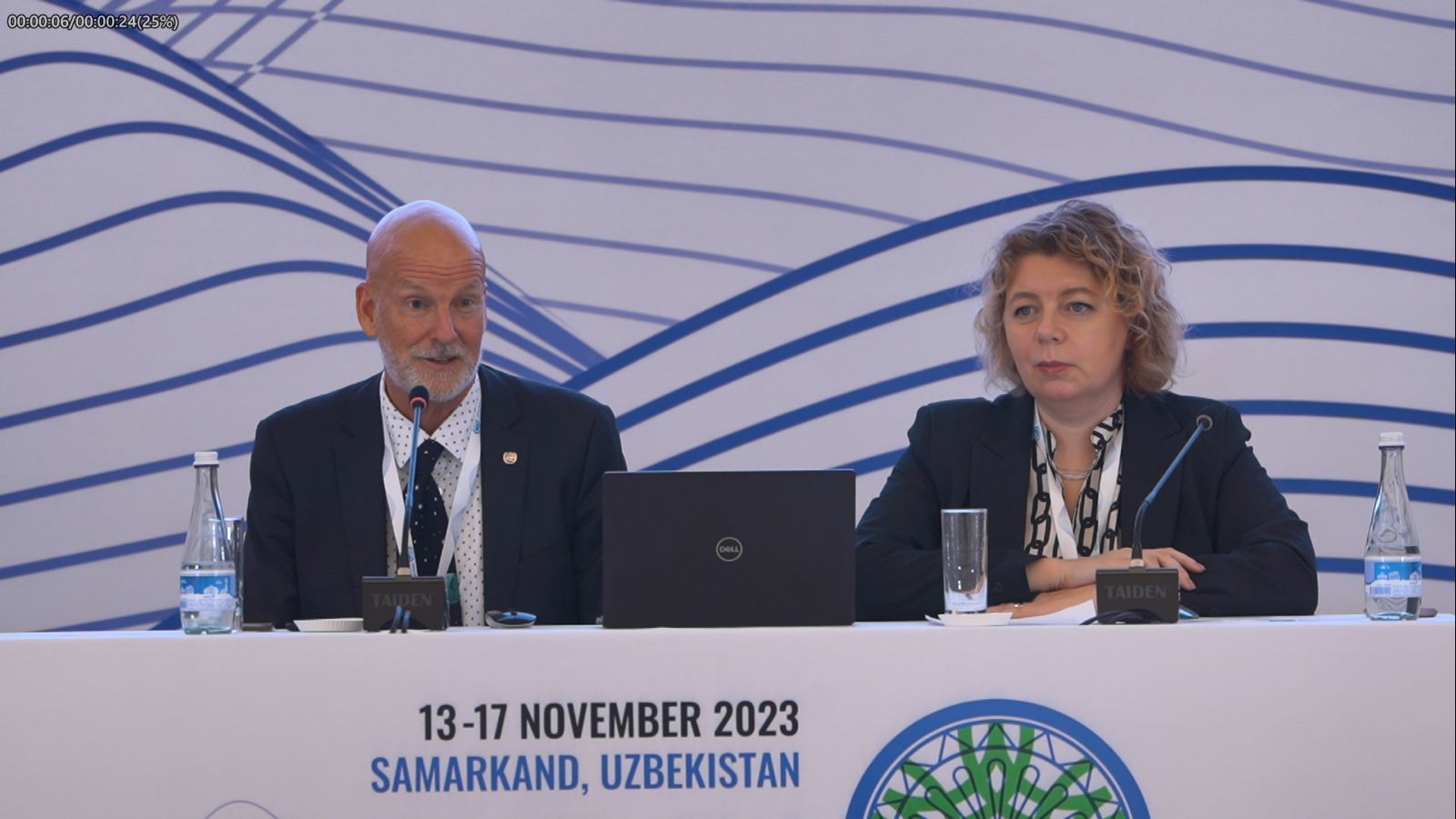SAMARKAND – The United Nations Convention to Combat Desertification (UNCCD) experts highlighted land management challenges specific to the Central Asian region, which include virgin lands history during the Soviet period, dust storms and shrinkage of the Aral Sea at the 21st session of the Committee on the Review of the Implementation of the Convention (CRIC21) on Nov. 13 in Samarkand, Uzbekistan.

UNCCD experts Barron Joseph Orr and Olga Andreeva at the press briefing related to Central Asian region. Photo credit: Almat Zhilkishin/kz.mir24.tv.
Overview of Central Asian land degradation
According to the latest UN data revealed at CRIC21, over 20% of the total land area in Central Asia is degraded, equivalent to roughly 80 million hectares, an area almost four times the size of the Kyrgyz Republic. This affects an estimated 30% of the region’s combined population.
“The five countries in the Central Asian region have a mostly negative trend in land degradation so far, but the Kyrgyz Republic and Uzbekistan have shown significant improvements in land condition,” said Olga Andreeva, UNCCD Program Officer of Science, Technology and Innovation unit.
Kazakhstan increased irrigated lands by 40%, expanding the total irrigated area to two million hectares. In the Kyrgyz Republic, 120,000 hectares of pastures and forests are now under sustainable land management, including a pasture rotation system. Turkmenistan committed to restoring 160,000 hectares under its national ‘greening the desert’ initiative by 2025.
While Uzbekistan reported the highest proportion of degraded land in the Central Asia region, it also saw the largest decrease from 30% to 26% compared to 2015. Three million hectares of land in Uzbekistan have been degraded due to the drying of the Aral Sea.
Between 2018 and 2022, Uzbekistan carried out saxaul planting on an area of 1.6 million hectares to eliminate salt and dust emissions from the drained bottom of the Aral Sea.
All Central Asian nations have joined the land degradation neutrality (LDN) target-setting program under UNCCD, bringing the total number of participating countries to 131. Half of the LDN targets set by countries in Central Asia have already been achieved, with projects to deliver on the rest of the commitments currently underway.
Challenges specific to Central Asia
UNCCD’s lead scientist Barron Joseph Orr said the history of inefficient land management during the Soviet era makes a unique case for the Central Asian land degradation problem.
“That is a big set of challenges that are unique in such dramatic change in how land is used and managed and owned, both before and after the change. I think that the region is learning a lot from those experiences,” he said.
“The second one is that there is an issue of salt-affected soils that is larger in many countries in Central Asia than it might be in other countries of the world. And then the third one, which I can’t say is unique to the region, but which the region is talking a lot about right now – because the severity is clearly going up – and that has to do with sand and dust storms,” added Orr.
“It will be appropriate to recall the tragedy of the Aral Sea, which was once called an emerald in a desert setting,” said Andreeva, joining Orr’s comments on region-specific challenges.
“At present, it is a desert created by human hands – Aralkum. But nevertheless, the efforts to restore these lands, namely the initiative to plant over one billion seedlings within five years, is worth the attention,” she said.
Region-specific solutions
According to Andreeva, the rehabilitation of land in Central Asia is a goal within reach.
“This region has huge potential. Competent use of land resources in conjunction with the introduction of sustainable land use practices can prevent and even reverse some land degradation processes. There are excellent examples of this,” said Andreeva.
According to Orr, regional challenges require region-specific solutions.
“I think it’s important to recognize that a lot of this region can be characterized as rangelands, so we’re not talking about forests and deforestation, we’re talking about very different systems that involve very different solutions and a lot of innovation in these more grassland-oriented systems where pastoralism is key,” said Orr.
“The example I will give you is something called carbon farming. In the news, you would think that forests conserve most of the carbon but actually grass has huge carbon sequestration potential and this region is looking at those opportunities economically,” he added.
Expanding on carbon farming, Andreeva said that “it is a set of practices and technologies that maximize the preservation of organic matter in the soil and multiply it, thereby preventing many degradation processes, primarily water-wind erosion of the soil.”
“The most important task is to return those lands that have been unwisely exploited to their natural state and to increase the reserves of soil organic matter. In this regard, achieving land degradation neutrality and achieving low-carbon agriculture go together,” added Andreeva.


